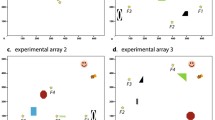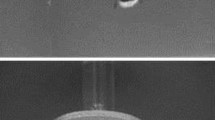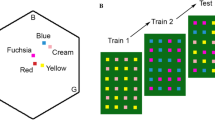Abstract
We describe a simple study of how bumblebees (Bombus spp.) behave when visiting florets which are arranged in a circle around a vertical inflorescence. In four species of bees, individuals showed a tendency for rotation in the same direction around each inflorescence on successive visits, i.e., each individual tended to go either clockwise or anticlockwise. Similar behavior has also been observed in mammals including humans. The implications of this tendency to repeat tasks in the same way are discussed, particularly in relation to our understanding of the phenomenon known as flower constancy. In humans, the tendency for individuals to turn in a particular direction is strongly related to handedness. In three of the four bee species there was a significant overall tendency for the bees to rotate in a preferred direction, suggesting that they too may exhibit handedness.
Similar content being viewed by others
REFERENCES
Chittka, L. (1998). Sensori-motor learning in bumble bees: Long-term retention and reversal training. J. Exp. Biol. 201: 515–524.
Chittka, L., and Thomson, J. D. (1997). Sensori-motor learning and its relevance for task specialization in bumble bees. Behav. Ecol. Sociobiol. 41: 385–398.
Chittka, L., Thomson, J. D., and Waser, N. M. (1999). Flower constancy, insect psychology, and plant evolution. Naturwissenschaften 86: 361–377.
Corbet, S. A., Cuthill, I., Fallows, M., Harrison, T., and Hartley, G. (1981).Why do nectar-foraging bees and wasps work upwards on inflorescences? Oecologia 51: 79–83.
Crawley, M. J. (1991). GLIM for Ecologists, Blackwell, Oxford.
Day, H. D., and Day, K. C. (1997). Directional preferences in the rotational play behaviors of young children. Dev. Psychobiol. 30: 213–223.
Ganskopp, D. (1995). Free-ranging Angora-goats-Left-handed or right-handed tendencies while grazing. Appl. Anim. Behav. Sci. 43: 141–146.
Giurfa, M., NÚñez, J. A., Chittka, L., and Menzel, R. (1995). Colour preferences of flower-naive honeybees. J. Comp. Physiol. A. 177: 247–259.
Goulson, D. (1999a). Foraging strategies for gathering nectar and pollen in insects. Perspect. Plant Ecol. Evol. Syst. 2: 185–209.
Goulson D. (1999b). Are insects flower constant because they use search images to find flowers? Oikos 88: 547–552.
Goulson, D., Hawson, S. A., and Stout, J. C. (1998) Foraging bumble bees avoid flowers already visited by conspecifics or by other bumblebee species. Anim. Behav. 55: 199–206.
Laverty, T. M. (1980). Bumble bee foraging: Floral complexity and learning. Can. J. Zool. 58: 1324–1335.
Laverty, T. M. (1994). Bumble bee learning and flower morphology. Anim. Behav. 47: 531–545.
Menzel, R. (1967). Untersuchungen zum Erlernen von Spektral-farben durch die Honigbiene (Apis mellifica). Z. Vergleichende Physiol. 56: 22–62.
Menzel, R. (1999). Memory dynamics in the honeybee. J. Comp. Physiol. A. 185: 323–340.
Menzel, R., and Erber, I. (1978). Learning and memory in bees. Sci. Am. 239: 102–110.
Menzel, R., Greggers, U., and Hammer, M. (1993). Functional organization of appetitive learning and memory in a generalist pollinator, the honey bee. In Papaj, D., and Lewis, A. C. (eds.), Insect Learning: Ecological and Evolutionary Perspectives, Chapman & Hall, London, pp. 79–125.
Menzel, R., Geiger, K., Chittka, L., Joerges, J., Kunze, J., and Muller, U. (1996). The knowledge base of bee navigation. J. Exp. Biol. 199: 141–146.
Menzel, R., Gumbert, A., Kunze, J., Shmida, A., and Vorobyev, M. (1997). Pollinators' strategies in finding flowers. Isr. J. Plant Sci. 45: 141–156.
Nielsen, D. M., Visker, K. E., Cunningham, M. J., Keller, R. W., Glick, S. D., and Carlson, J. N. (1997). Paw preference, rotation, and dopamine function in collins HI and LO mouse strains. Physiol. Behav. 61: 525–535.
Southwick, E. E., and Buchmann, S. L. (1995). Effects of horizon landmarks on homing success in honey-bees. Am. Nat. 146: 748–764.
Stout, J. C., Goulson, D., and Allen, J. A. (1998). Repellent scent marking of flowers by a guild of foraging bumblebees (Bombus spp.). Behav. Ecol. Sociobiol. 43: 317–326.
Thomson, J. D., Maddison, W. P., and Plowright, R. C. (1982). Behavior of bumble bee pollinators of Aralia hispida Vent. (Araliaceae). Oecolgia 54: 326–336.
Thomson, J. D., Peterson, S. C., and Harder, L. D. (1987). Response of traplining bumble bees to competition experiments: shifts in feeding location and efficiency. Oecologia 71: 295–300.
Westergaard, G. C., and Suomi, S. J. (1996). Lateral bias for rotational behavior in tufted capuchin monkeys (Cebus apella). J. Comp. Psychol. 110: 199–202.
Williams, C. S. (1998). The identity of the previous visitor influences flower rejection by nectar-collecting bees. Anim. Behav. 56: 673–681.
Woodward, G. L., and Laverty, T. M. (1992). Recall of flower handling skills by bumblebees: A test of Darwin's interference hypothesis. Anim. Behav. 44: 1045–1051.
Yazgan, M. Y., Leckman, J. F., and Wexler, B. E. (1996). A direct observational measure of whole body turning bias. Cortex 32: 173–176.




